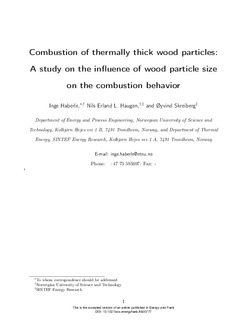| dc.contributor.author | Haberle, Inge | |
| dc.contributor.author | Haugen, Nils Erland L | |
| dc.contributor.author | Skreiberg, Øyvind | |
| dc.date.accessioned | 2019-01-09T13:08:42Z | |
| dc.date.available | 2019-01-09T13:08:42Z | |
| dc.date.created | 2018-05-24T13:26:32Z | |
| dc.date.issued | 2018 | |
| dc.identifier.citation | Energy & Fuels. 2018, 32 (6), 6847-6862. | nb_NO |
| dc.identifier.issn | 0887-0624 | |
| dc.identifier.uri | http://hdl.handle.net/11250/2579985 | |
| dc.description.abstract | A one-dimensional (1D) comprehensive combustion model for thermally thick wet wood particles, which is also applicable for studying large wood logs, is developed. The model describes drying, devolatilization, and char gasification as well as char oxidation. Furthermore, CO oxidation is modeled, in order to account for the fact that exiting gas products can be oxidized and therefore limit the oxygen transportation to the active sites. The challenges for model validation are outlined. Model validation was done against experimental data for combustion of near-spherical wood particles. Furthermore, the validated model was up-scaled and the effect of wood log diameter on the thermal conversion time, the extent as well as the position of drying, devolatilization, and char conversion zones were studied. The upscaling was done for cylindrical wood logs with an aspect ratio of 4. The thermal conversion time significantly increased with the size. It was also found that the relative extent of the drying, devolatilization, and char conversion zones decreased as wood log size increased. The paper concludes with recommendations for future work. | nb_NO |
| dc.language.iso | eng | nb_NO |
| dc.publisher | American Chemical Society | nb_NO |
| dc.title | Combustion of Thermally Thick Wood Particles: A Study on the Influence of Wood Particle Size on the Combustion Behavior | nb_NO |
| dc.type | Journal article | nb_NO |
| dc.type | Peer reviewed | nb_NO |
| dc.description.version | acceptedVersion | nb_NO |
| dc.source.pagenumber | 6847-6862 | nb_NO |
| dc.source.volume | 32 | nb_NO |
| dc.source.journal | Energy & Fuels | nb_NO |
| dc.source.issue | 6 | nb_NO |
| dc.identifier.doi | 10.1021/acs.energyfuels.8b00777 | |
| dc.identifier.cristin | 1586440 | |
| dc.relation.project | Norges forskningsråd: 243752 | nb_NO |
| dc.description.localcode | © American Chemical Society 2018. This is the authors accepted and refereed manuscript to the article. Locked until 6.6.2019 due to copyright restrictions. | nb_NO |
| cristin.unitcode | 194,64,25,0 | |
| cristin.unitname | Institutt for energi- og prosessteknikk | |
| cristin.ispublished | true | |
| cristin.fulltext | postprint | |
| cristin.qualitycode | 2 | |
